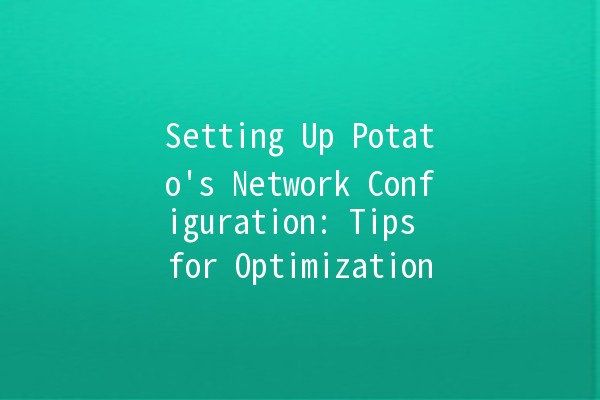When it comes to configuring the network settings for a device like Potato, having a wellstructured approach can make all the difference. Whether you're managing a local network or integrating it within a larger infrastructure, ensuring optimal performance is crucial. In this article, we will delve into practical tips and techniques that can enhance Potato’s network configuration. Along the way, we will cover specific productivityenhancing strategies that will help you maximize efficiency.
Understanding Potato's Network Framework
Before diving into specific settings, it’s essential to grasp the overarching framework of Potato's network configuration. Potato typically connects through Ethernet or WiFi, allowing for versatile deployment options based on your environment's needs. This section will outline the necessary components and tools required for effective network management.
Key Components

Router: This device links your Potato to the internet, managing incoming and outgoing traffic.
Switch: If you are connecting multiple devices, a switch helps manage data sharing efficiently.
Firewall: Ensures your network remains secure by filtering incoming and outgoing traffic.
Ethernet Cables: Essential for wired connections, providing stability and speed.
Tools Needed
Network Configuration Software: Applications like Wireshark or SolarWinds can help analyze traffic.
Admin Console: Accessing the router’s admin panel is vital for configuring settings directly.
Security Software: Protects your network from potential threats.
Five Key Tips to Enhance Productivity
Below we outline five productivityenhancing tips for configuring Potato’s network settings effectively:
Managing IP addresses is essential for maintaining a seamless connection. Using Dynamic Host Configuration Protocol (DHCP) simplifies this process.
How to Apply:
Access your router's settings to enable DHCP.
Set a range for assigning IP addresses.
Ensure Potato is configured to accept DHCP.
By using DHCP, you reduce the chances of IP conflicts, leading to more stable connections and less downtime.
Implementing QoS allows you to prioritize specific types of traffic, which can greatly improve performance for critical applications such as video streaming or VoIP calls.
How to Apply:
Log in to your router’s settings.
Locate the QoS configuration section.
Assign priority levels to different applications based on your usage needs.
By prioritizing essential applications, you can enhance the overall user experience on your network.
Segmenting your network can lead to better security and improved performance by minimizing congestion. This is especially useful in environments with multiple devices.
How to Apply:
Create separate VLANs (Virtual Local Area Networks) for different departments or device types.
Adjust firewall settings to control access between these segments.
This practice limits broadcast traffic, enhances security, and provides better control over the network.
Keeping your router’s firmware up to date is crucial for security and performance improvements. Manufacturers frequently release updates to fix vulnerabilities and improve device efficiency.
How to Apply:
Check your router manufacturer's website for the latest firmware version.
Follow the update instructions carefully, ensuring no interruption during the process.
Regular updates will ensure that Potato benefits from the latest features and security patches.
Using a Virtual Private Network (VPN) can encrypt your network traffic, providing an additional layer of security, especially when using public WiFi.
How to Apply:
Choose a reputable VPN service that fits your usage.
Configure your VPN settings on both the router and Potato.
Ensure that all devices connected to the network route through the VPN.
This enhances privacy and data security significantly, protecting sensitive information from potential threats.
Common Challenges in Network Configuration
When multiple devices attempt to use the same IP address, conflicts arise, leading to connectivity issues.
If you fail to prioritize traffic or overuse bandwidth, performance can drop drastically.
Failure to secure your network leaves it vulnerable to attacks, which could compromise sensitive data.
Rushing through the setup process can lead to errors, resulting in an inefficient network.
Not possessing sufficient troubleshooting skills can prolong downtime when issues inevitably arise.
FAQ Section
What should I consider when connecting Potato via WiFi?
When connecting Potato through WiFi, consider the signal strength and interference from other devices. Position your router centrally, avoid obstacles, and ensure your network is on a less congested channel.
How can I troubleshoot connection issues with Potato?
To troubleshoot connection issues, first restart Potato and your router. Check all physical connections, update firmware, and ensure your settings are configured properly. Use a network diagnostic tool to further identify issues.
Is it necessary to use a firewall when setting up Potato’s network?
Yes, using a firewall is crucial for protecting your network from unauthorized access and potential threats. Ensure that your router’s firewall is enabled and configured correctly.
How can I monitor network performance with Potato?
You can monitor network performance by using network management software or tools that analyze bandwidth usage and connectivity. Regularly check these metrics to identify and resolve potential issues early.
Should I disable unused services on Potato for better performance?
Disabling unused services can enhance performance by freeing up system resources. Review what services Potato is running and disable any that are unnecessary for your intended operations.
How often should I update my network device firmware?
It is advisable to check for firmware updates at least once a month. Keeping devices updated ensures you benefit from security enhancements and performance improvements.
al Thoughts
Configuring Potato’s network settings can seem daunting, but applying these practical productivity tips will facilitate a smoother setup and operational efficiency. Regular monitoring and appropriate adjustments are key to maintaining optimal performance. Keep learning about new networking developments and tools, and you'll find that your network configuration skills will continually improve, leading to a robust and reliable connection for Potato and other devices in your setup.
Engage with your network environment, and accept the challenges that come with it; effective network configuration is an ongoing journey rather than a destination.